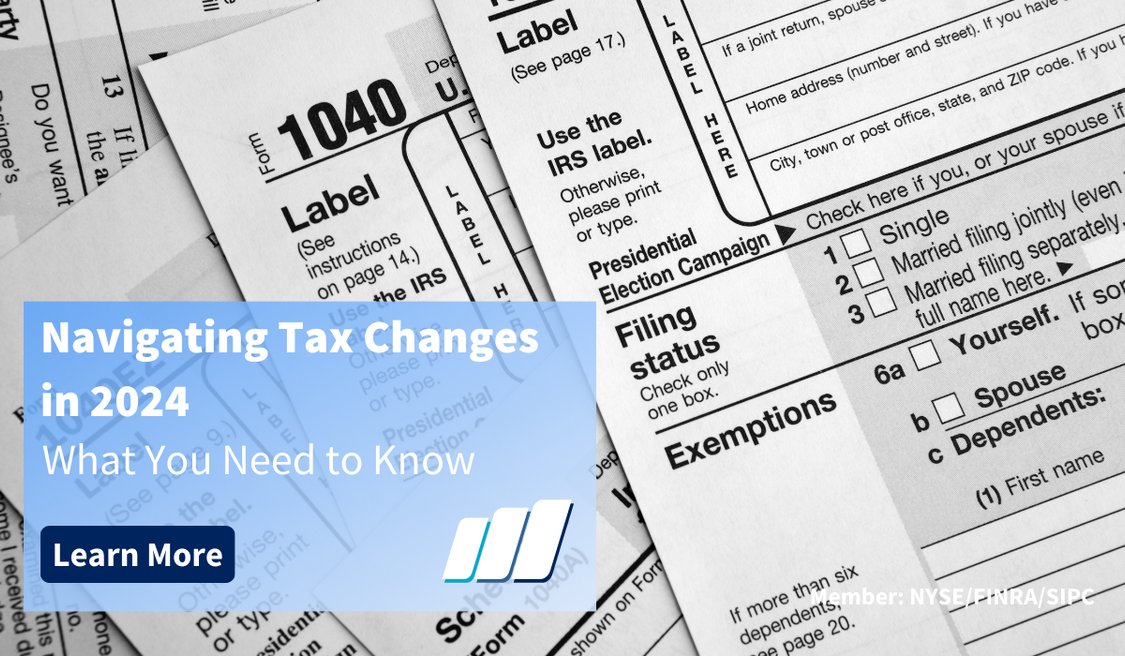Each new year brings a number of tax changes for taxpayers. This is the case for 2024. There are important changes that taxpayers should be aware of in their tax planning for 2024. Here is a look at some of them.
Tax Brackets
Changes to the marginal income tax brackets in line with inflation will be in effect for the 2024 tax year. Here are the marginal 2024 tax rates.
|
Marginal Tax Rate |
Single | Married Filing Joint | Married Filing Separate | Head of Household |
|
10% |
$0 to $11,600 |
$0 to $23,200 |
$0 to $11,600 |
$0 to $16,550 |
|
12% |
$11,601 to $47,150 |
$23,201 to $94,300 |
$11,601 to $47,150 |
$16,551 to $63,100 |
|
22% |
$47,151 to $100,525 |
$94,300 to $201,150 |
$47,151 to $100,525 |
$63,101 to $100,500 |
|
24% |
$100,525 to $191,950 |
$201,150 to $383,900 |
$100,525 to $191,950 |
$100,501 to $191,950 |
|
32% |
$191.950 to $243,725 |
$383,900 to $487,450 |
$191,950 to $243,725 |
$191,950 to $243,700 |
|
35% |
$243,725 to $609,350 |
$487,450 to $732,200 |
$243,725 to $365,600 |
$243,700 to $609,350 |
| 37% | $609,351 or more | $732,201 or more | $365,601 or more |
$609,351 or more |
The 2024 marginal tax brackets are about 5.4% higher than the corresponding 2023 brackets. This can play into your 2024 tax planning in terms of being able to earn a bit more than in 2024 without moving into a higher bracket. This could impact retirement account distributions and other types of income.
Standard Deduction
The standard deduction has increased for 2024 as follows:
- For single filers, the 2024 standard deduction is $14,600 – up from $13,850 for the 2023 tax year.
- For those filing married and joint, the 2024 standard deduction is $29,200 – up from $27,700 for the 2023 tax year.
These increases could help reduce taxable income for some filers, it will also raise the threshold to be able to itemize deductions on your return.
Annual Gift Tax Exclusion
For those who are looking to make gifts to family members or others, the annual gift tax exclusion for 2024 will increase to $18,000 from $17,000 in 2023. This is the amount that you can give to anyone without having any part of the gift count against your lifetime estate and gift tax exclusion.
Retirement Plan Contributions
The annual limits for contributions to retirement plans are increasing in 2024 as well.
- The annual limit for IRA contributions is increasing from $6,500 to $7,000. The catch-up contribution limit for those who are 50 or over will remain the same at $1,000.
- The annual contribution limits for 401(k)s, 403(b) plans, most 457 plans and the government Thrift Saving Plan have increased to $23,000, up from $22,500 in 2023. The catch-up contribution limit will remain at $7,500 for 2024.
- For those who are self-employed, the annual contribution limit for a SEP-IRA plan is increasing to $69,000 from $66,000 for 2023. Note all contributions to a SEP-IRA are made by the employer.
- The contribution limits for SIMPLE IRAs have increased to $16,000 from $15,500 in 2023. The catch-up contribution for those who are 50 or over will remain at $3,500 for 2024.
These increased retirement plan contribution limits allow for greater pre-tax contributions, and tax savings, on contributions made to a traditional IRA or retirement plan account. While contributions to a Roth account are made with after-tax dollars, the money in these accounts grows tax-free and can be withdrawn tax-free as long as the criteria for a qualified distribution are met.
EV Tax Credit
For those looking to buy an electric vehicle in 2024, there have been some changes to the EV tax credit.
One big change is the ability of buyers to receive an instant credit that can be used as a down payment on qualifying new or used vehicles. This can help reduce their out-of-pocket cost for the vehicle and can help reduce any amount that might need to be financed. They can also continue to defer the credit to use when they file their 2024 tax return.
Qualified Charitable Distributions (QCDs)
The Secure 2.0 rules call for the level of qualified charitable distributions that can be taken by those who are at least 70 ½ from their traditional IRA accounts to increase by inflation each year beginning in 2024. The limit for 2024 is $105,000 which is up from the original limit of $100,000 in prior years.
QCDs are a tax-efficient way for those who cannot itemize charitable deductions to donate to charity. While QCDs are not tax deductible they do come out of the IRA tax-free. For those who are of an age where they are taking required minimum distributions from their TRA, QCDs can be used to cover some or all of their RMD, eliminating the tax on these distributions. Note the sequencing of the QCD versus other withdrawals from the IRA is important in using the QCD to satisfy some or all of the RMD requirement.
These are a few of the tax changes to be aware of for 2024. You will want to discuss your situation with your tax professional and your Wedbush advisor or registered representative to be sure that you are incorporating all eligible tax breaks into your financial planning for 2024 and beyond.
